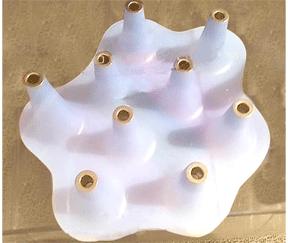
As a former member of the board of directors of The Jewish Museum in New York, Sybil Kahn had seen a variety of Hanukkiot displays. She enjoyed their beauty and thought such a display would be a great way for the Jewish Community Center of Greater Kansas City (The J) to promote Jewish heritage. Jill Maidhof, The J’s director of Jewish experiences, agreed with Kahn and Festival Lights: Hanukkah Lamps from Private Collections was conceived.
“The Jewish Museum had a tremendous collection of menorahs and it was so gorgeous the way they used to present them,” said Kahn of her idea for a display here. “I think the Jewish Community Center is going to do a great job with this exhibit.”
The exhibit opens at The J in the main lobby of the Jewish Community Campus on Tuesday, Nov. 28, with a reception featuring kosher wine and dessert. The reception is free and open to the community. The exhibition continues through Sunday, Dec. 17. It features about 40 Hanukkiot from the personal collections of Michael Klein, Dr. Sol and Mickey Batnitzky, Dr. Jonathan and Ellen Chilton, Gary Cortes, Sybil Kahn, and Fred and Sherri Kahn.
The curated exhibition will feature a wide variety of styles: artistically and historically “important” pieces; unique works from a variety of countries, highly contemporary pieces and whimsical works. Some tell the story of a culture while others are highly personal mementoes of family trips and holiday celebrations. All of them represent their owners’ passion for the aesthetic and love of Jewish expression.
When Sybil Kahn, a longtime collector and arts advocate, contacted Maidhof with her idea, she had already enlisted Klein’s help. Maidhof said Klein “was enthusiastic about lending part of his exquisite collection” for such an exhibition.
“Who could turn that down? We made the decision to focus on Hanukkiot — Hanukkah menorahs. I immediately called Ellen Chilton, whose expertise in Judaica is well known, and she was good enough to advise me, as she has in the past. It was Ellen who connected with Gary Cortes and Sol and Mickey Batnitzky. She and her husband Jonathan had several family Hanukkiot and of course she had several beautiful pieces in Pomegranate, her Judaic gallery, and the Kahn family rounded out the selections,” Maidhof said.
Maidhof added, “It was a real privilege to visit each home, view the collection, hear the stories and select just a few pieces from so many beautiful choices.”
Accompanying the artwork will be signage describing the evolution of the Hanukkiah as well as examples of its political, religious, historical and highly personal significance.
The exhibit will feature about a dozen of Klein’s Hanukkiot from his extensive Judaica collection, which includes about 40 Hanukkiot. He started his Judaica collection about 45 years ago with antique spice boxes and eventually began collecting other items. He thinks the Hanukkiot exhibit will interest people because the ones that will be displayed are so different.
“They reflect the times, the cultures, the countries where people were living. They chose one of mine from Afghanistan, which is totally different than any of the others on display. The one featuring the Statue of Liberty that the Batnitzkys have, or their Liberty Bell menorah, reflect our country versus those from Poland or Germany or North Africa. I think it’s interesting how different cultures influence the menorahs that they used.
“The different times are represented also. You have oil burning versus candles. Today almost everybody uses candles, some people still burn oil and there are ones that are electric.”
A Hanukkiah from Sybil Kahn’s collection by Israeli artist and sculptor Yaacov Agam, who is considered a pioneer and leading exponent of optical and kinetic art and is best known for his three-dimensional paintings and sculptures, will also be on display.
“I think the entire exhibit will be stunning,” she said.
Maidhof credits the Epsten Gallery for help with this exhibition.
“We couldn’t bring this show to the public without the Epsten Gallery. Not only is the organization lending critical display materials, curator Heather Lustfeldt will be providing curatorial assistance. We’re blessed to have such great neighbors,” she said.



